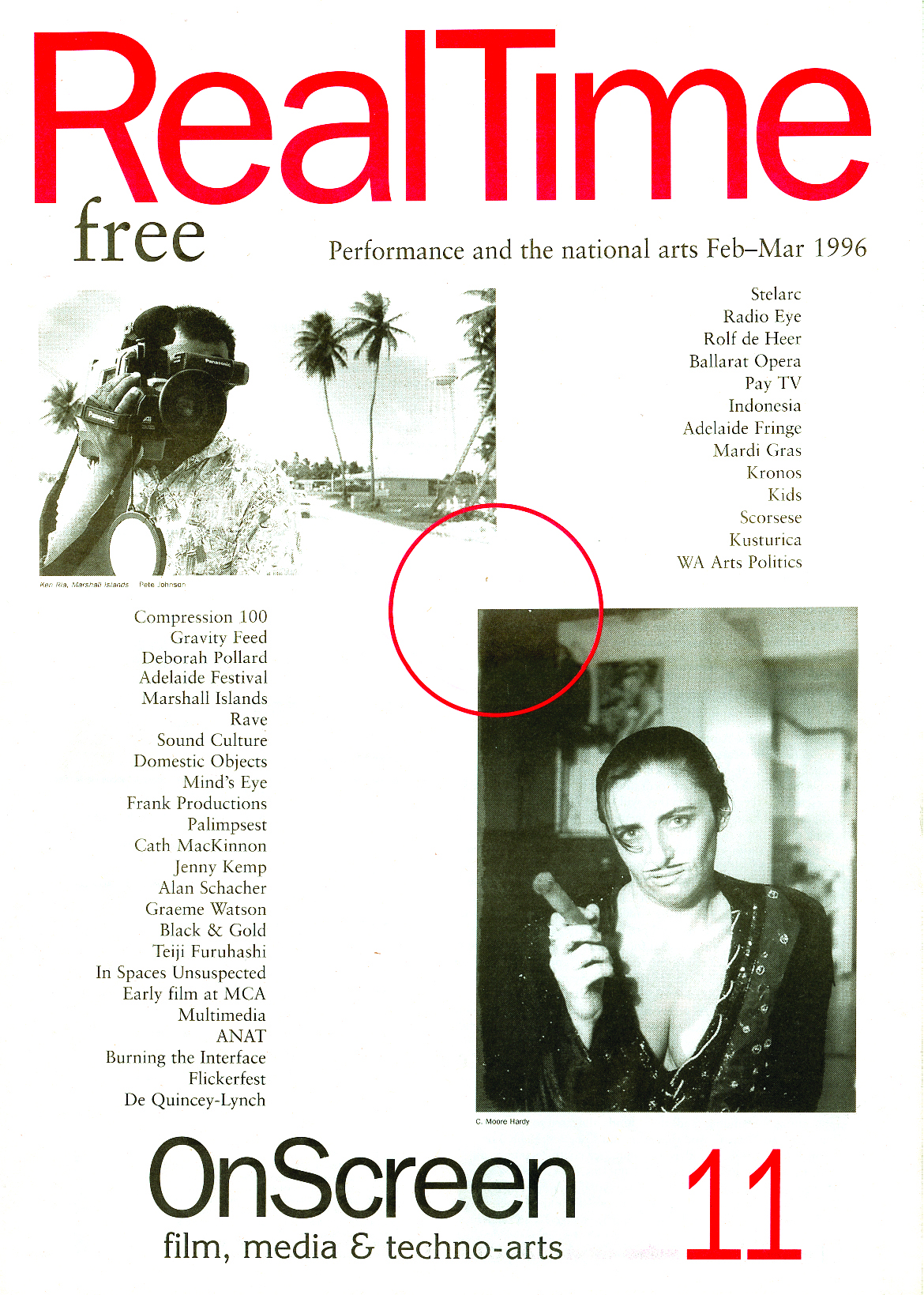
Editorial, RealTime 11, February-March 1996
Welcome to RealTime 11 incorporating our first screen culture supplement OnScreen. With support from the Australian Film Commission, OnScreen aims to bring you engaging, critical and informed writing on film, media and techno-arts from across Australia. OnScreen will reflect RealTime’s broader focus on mixing genres and blurring boundaries, especially appropriate as aspects of screen culture become increasingly interlinked in the wake of technological, aesthetic and policy developments. Our first issue gives some indication of OnScreen’s scope: Media analyst Gil Appleton clarifies the confusion around the interminable policy permutations in Pay TV; Balkans commentator Eddy Jokovich casts a critical eye over Kusturica’s Underground; John McConchie interviews director of Bad Boy Bubby Rolf de Heer about his new film The Quiet Room; John Conomos surveys CD ROM based artform practice in his preview of the MCA’s Burning the Interface exhibition; two writers coming from very different perspectives size up Larry Clark’s Kids, Boris Kelly visits Stelarc’s web site and Anna Dzenis engages with the textuality of Lesley Stern’s new book The Scorsese Connection. We also bring you reviews of recent new media conferences, Flickerfest, the recent UNSW College of Fine Arts screenings, and new interactive media installations, plus previews of the Adelaide Festival film program, the MCA’s major retrospective of early film and the Mardi Gras Film Festival. We’d welcome your feedback, and hope you enjoy OnScreen.
Realtime 11 is strong on process in performance, dance and music, whether it’s Jenny Kemp and Cath MacKinnon on preparing new works for the Adelaide Festival, Tess De Quincey and Stuart Lynch planning ‘to dance Sydney’ in 100 performances, John Nobbs and Jacqui Carroll discussing performance and training for their Suzuki Tadashi-inspired Frank Productions, choreographer Graeme Watson shaping Antwatchers for One Extra, Deborah Pollard describing the evolution of a work with Indonesian actors and farmers, David Harrington on the Kronos Quartet ‘as process’, Ion Pierce and Nicholas Gebhardt musing on the politics of composition and Alice Cummins on the contribution of her studio to her work, as well as Jan Cattoni reporting on the making and teaching of documentary filmmaking in the Marshall Islands.
On the arts politics front the concern among artists over the restructuring of the Australia Council persists. The issue of artist representation appears to have been resolved with the Australia Council confirming its commitment to peer assessment and the establishment of a range of artform funds in which artists will be represented in the majority, as they will be on Council. MOB has also become a fund (MOF) but its members still don’t have an artist among them they can talk to about art! The Foundation for Culture and the Humanities, on which artists were poorly represented, has parted company with the Australia Council, apparently on the grounds that its brief is broader—“heritage, civics, centenary and Federation”, said departing director Craddock Morton, to which we could add Fundraising. The issue now is the fate of specific artforms in terms of funding strategies and programs. The second round of the consultative Australia Council forums have been suspended until after the elections. Meanwhile the restructuring goes on and the new coverall Handbook will be released in April. So much for consultation. The pre-Xmas forums were hardly models of excellence—brief meetings crowded with more questions than could be answered. A day in each city would have been ideal with carefully planned agendas, brief keynote addresses and ample discussion time. Too much to hope for?
Hybrid artists were alarmed at the forums to find themselves missing from the list of Funds and the list of closing dates for applications for funding, and ‘their’ funds allocated to an Advisory Committee to Council. And they were not to be represented on Council. In principle, an advisory committee could encourage all funds to think in terms of innovative interdisciplinary work, even talk to each other. However the Hybrid Arts has been supporting distinctive work in sound, the body, multimedia and interactivity. As the funded area most directly and critically engaged with the issues of Creative Nation it seems shortsighted to fail to acknowledge Hybrid Arts as a growing area of activity (not a form), as a Fund and as worthy of representation on Council.






